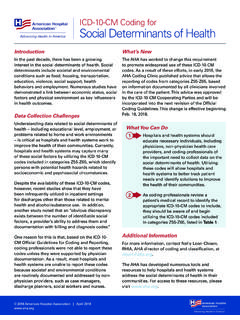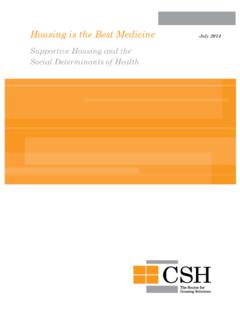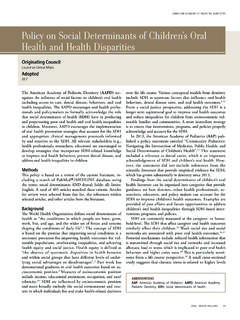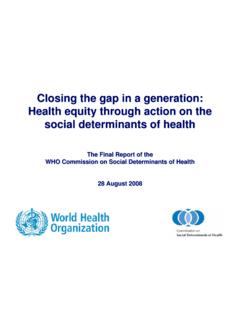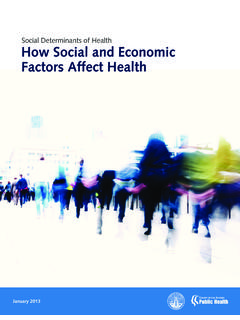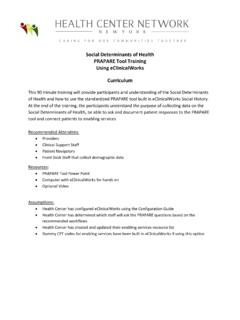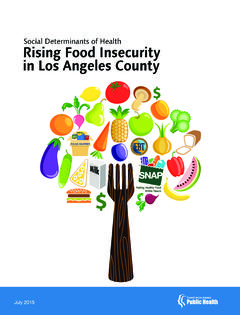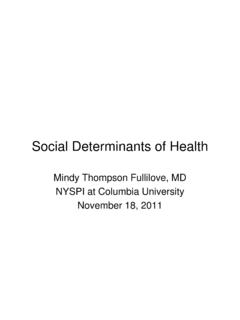Transcription of LEVERAGING THE SOCIAL DETERMINANTS OF …
1 LEVERAGING THE SOCIAL DETERMINANTS OF health : WHAT WORKS?JUNE 2015prepared for the Blue Cross Blue Shield of Massachusetts Foundation by Lauren A. Taylor, Caitlin E. Coyle, Chima Ndumele, Erika Rogan, Maureen Canavan, Leslie Curry, and Elizabeth H. Bradley[ 2 ]TABLE OF CONTENTSEXECUTIVE ..8 SECTION 1: THE MASSACHUSETTS CONTEXT ..10 SECTION 2: THE health IMPACT OF SOCIAL SERVICES ..11 HOUSING ..11 NUTRITIONAL ASSISTANCE ..15 WOMEN, INFANTS, AND CHILDREN (WIC) ..16 LOW-INCOME FAMILIES AND OLDER ADULTS ..17 EDUCATION ..18 NEIGHBORHOOD CONDITIONS AND PUBLIC SAFETY ..18 INCOME SUPPORT ..19 SECTION 3: THE health IMPACT OF PARTNERSHIPS BETWEEN health CARE AND SOCIAL SERVICES.
2 21 CASE MANAGEMENT AND CARE COORDINATION ..21 COMMUNITY OUTREACH AND MOBILE CLINICS ..26 INTEGRATED health CARE AND HOUSING SERVICES ..28 SECTION 4: GAPS IN THE LITERATURE AND AREAS FOR FURTHER RESEARCH ..31 CONCLUSION ..33 BIBLIOGRAPHY ..34 APPENDICES ..42 APPENDIX A: METHODS ..42 APPENDIX B: LIST OF NO EFFECT PAPERS ..44 APPENDIX C: SUMMARY BOXES ..45[ 3 ]EXECUTIVE SUMMARYS ocial DETERMINANTS of health which encompass SOCIAL , behavioral, and environmental influ-ences on one s health have taken center stage in recent health policy discussions, particularly with the growing focus on global payment, accountable care organizations, and other initiatives focusing on improving population health .
3 Research indicates that greater attention to SOCIAL DETERMINANTS of health may both improve Americans health and reduce health care costs. Nevertheless, translating this evidence into actionable recommendations for policy makers and others has been challenging. This report evaluates and summarizes the evidence base for interventions that address SOCIAL DETERMINANTS of health , paying special attention to the innova-tive models that may improve health outcomes and reduce health care costs and that may be applicable in the Massachusetts policy context. Summarized below are key conclusions and recommendations based on this evaluation.
4 First, the existing literature is clear about the importance of SOCIAL DETERMINANTS of health in improving the health of populations. Extensive scientific literature has investigated the relative contributions of genetics, health care, and SOCIAL , environmental, and behavioral factors in promoting health and reducing premature mortality (Chiu et al., 2009; Lee & Paxman, 1997). These studies uniformly suggest that nonmedical factors play a substantially larger role than do medical factors in DETERMINES health ? (ADAPTED FROM MCGINNIS ET AL., 2002 )GENETICS20% health CARE20% SOCIAL , ENVIRONMENTAL, BEHAVIORAL FACTORS60%Second, there is strong evidence that increased investment in selected SOCIAL services as well as various models of partnership between health care and SOCIAL services can confer substantial health benefits and reduce health care costs for targeted populations.
5 These programs may be deserving of immediate attention from Massachusetts policy makers, providers, plans, and other stakeholders. The programs include: Housing support for low-income individuals and families: The evidence demonstrating a direct relationship between housing interventions and health outcomes within low-income and otherwise vulnerable populations is expansive. The studies that were reviewed here (see Section 2: The health Impacts of SOCIAL Services Housing) indicate that providing housing support for low-income, high-need individuals results in net savings due to reduced health care costs. In some studies, the medical savings more than offset the additional costs of providing housing supports.
6 The net savings range from $9,000 per person per year to nearly $30,000 per person per year for the Housing First model, a harm-reduction approach in which [ 4 ]adults who are homeless and who have behavioral health conditions are provided supportive housing without having to abstain from drugs and alcohol (Larimer et al., 2009; Massachusetts Housing and Shelter Alliance, 2009). The 10th Decile Project found that for every $1 spent, there was a savings of $2 in reduced spending the following year and $6 savings in subsequent years (Burns, Sumner, & Lee, 2013). Furthermore, the evidence indicates that the integration of housing with health care services can result in improved health outcomes.
7 Nutritional assistance for high-risk women, infants, and children as well as older adults and people with disabilities: The evidence base for health impacts of nutritional assistance programs is robust (see Section 2: The health Impact of SOCIAL Services Nutritional Assistance). For example, observation of participants in the Supplemental Nutrition Program for Women, Infants, and Children (WIC) showed lower infant mortality rates and higher average birth weights for WIC participants than for non-WIC participants (Foster, Jiang, & Gibson-Davis, 2010). Moreover, a review by the Government Accountability Office (GAO) in 1992 reported that WIC cost $296 million per year but avoided more than $472 million in expected fed-eral and state Medicaid costs ( GAO, 1992).
8 Similarly, national evidence indicates that home-delivered meals for older adults and people with disabilities improve physical and mental health and reduce Medicaid costs. One study estimated that every $25 increase in home-delivered meals per older adult would be associated with a 1 percent decline in nursing home admissions (Thomas & Mor, 2013). Case management and community outreach for high-need, low-income families and older adults as well as for children with asthma: The studies reviewed here (see Section 3: The health Impact of Partnerships Between health Care and SOCIAL Services Case Management and Care Coordination) suggest that these vulnerable populations experience health gains when their care is coordinated across primary, specialty, behavioral, and SOCIAL services and that hospitalizations and emer-gency department visits are demonstrably reduced.
9 For example, studies of the Nurse-Family Partnership consis-tently found lower rates of infant and child mortality, lower total Medicaid spending, and improved mental health rela-The 10TH DECILE PROJECT is a public-private partnership that provides permanent supportive housing to those homeless patients identified by hospitals as having the highest public and hospital costs. The SUPPLEMENTAL NUTRITION PROGRAM FOR WOMEN, INFANTS, AND CHILDREN (WIC) provides federal grants to states for supplemental foods, health care referrals, and nutrition education for low-income pregnant, breastfeeding, and non-breastfeeding postpartum women, and to infants and children up to age five who are found to be at nutritional NURSE-FAMILY PARTNERSHIP is a program that serves at-risk mothers who have recently had their first child and enables nurses to visit the mothers at home and assist with building competency in child care, developing self-care, completing education, and finding employment.
10 [ 5 ]tive to groups that do not participate in the Nurse-Family Partnership (Olds et al., 2007; Olds et al., 2014; Eckenrode et al., 2010; Olds et al., 2004). A cost-effectiveness analy-sis of the Memphis Nurse-Family Partnership site found a savings in medical and SOCIAL service spending over a 12-year follow-up period that exceeded program costs by $789 per family (Olds et al., 2010). In addition, an evalu-ation of the Geriatric Resources for Assessment and Care of Elders (GRACE) model of care demonstrated that GRACE model participants were more likely to score better on a self-rated health survey. Moreover, the participants in the GRACE model had a lower rate of visits to the emergency department than did a comparison group that did not receive this model of care (Counsell et al.)
